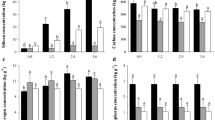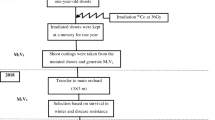Abstract
STUDIES of the use of phosphorus-32 for the production of somatic mutations in the potato require a knowledge of the amount of active material which, as part of the nutrient solution, would produce toxic effects at the growing points. Further, the concentration of phosphorus-32 in the growing point must be known if an estimate is to be made of the radiation dose received. A knowledge of the dose received is essential in order to make comparisons of the effects produced with those resulting from similar doses of other types of ionizing radiation. In this communication, experiments with phosphorus-32 on three varieties of potato (Gladstone, Edzell Blue and Arran Pilot) are described.
This is a preview of subscription content, access via your institution
Access options
Subscribe to this journal
Receive 51 print issues and online access
$199.00 per year
only $3.90 per issue
Buy this article
- Purchase on Springer Link
- Instant access to full article PDF
Prices may be subject to local taxes which are calculated during checkout
Similar content being viewed by others
References
Scott-Russell, R., and Martin, R. P., Nature, 163, 71 (1949).
Marinelli, L. D., Amer. J. Roentgenol. and Rad. Therapy, 47, 210 (1942).
Mayneord, W. V., Brit. J. Radiol., Supp. No. 2, 145 (1950).
Sinclair, W. K. (in the course of publication).
Author information
Authors and Affiliations
Rights and permissions
About this article
Cite this article
STANTON, W., SINCLAIR, W. Effect of High Concentration of Phosphorus-32 on Growth of the Potato. Nature 167, 234–235 (1951). https://doi.org/10.1038/167234a0
Issue Date:
DOI: https://doi.org/10.1038/167234a0
This article is cited by
-
Effects of gamma-rays on segregation ratios in potato families
Potato Research (1972)
-
Induction of some rare somatic mutations in Solanum tuberosum L. by ionizing radiations and radiophosphorus
European Potato Journal (1969)
-
Mutations in potatoes induced by gamma irradiation
Euphytica (1967)
-
The chimærical structure of a somatic solanum mutant revealed by ionizing irradiation
Genetica (1963)
-
Studies of mineral nutrition by use of tracers
The Botanical Review (1955)
Comments
By submitting a comment you agree to abide by our Terms and Community Guidelines. If you find something abusive or that does not comply with our terms or guidelines please flag it as inappropriate.



